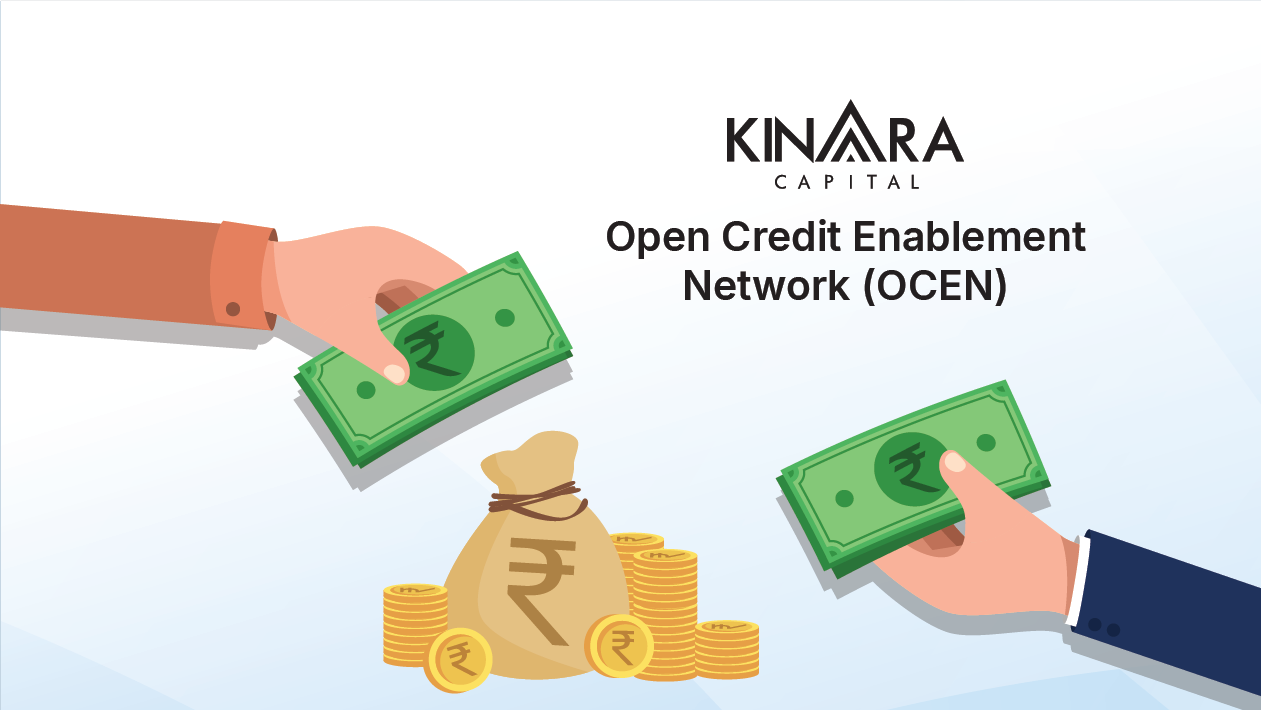
For the past decade or so, various tech disruptions have been transforming the financial landscape in India. This is also true for last-mile lending, which has undergone a sea change owing to this tech transformation. As the “next billion” customers come on board, armed with smartphones and internet access, technology is also advancing in leaps and bounds to keep up with their specific needs.
One of the latest in a series of developments aimed at further easing and securing credit access for last-mile borrowers is the advent of the OCEN. The full form of OCEN stands for Open Credit Enablement Network, and is aimed at facilitating micro-small-and-medium enterprises (MSMEs) to access financing and help them stand to gain significantly with the implementation of this framework.
OCEN in India is a transformative initiative aimed at revolutionising the credit landscape for MSMEs. By creating a standardised, open network, OCEN simplifies access to financial products from various lenders. This framework fosters competition, enhances transparency, and improves the efficiency of credit disbursement, thereby supporting the growth and sustainability of MSMEs, which are vital to India’s economic development.
The government announced the launch of OCEN at the Global Fintech Festival 2020. It is a framework of application programming interfaces (APIs) aimed at facilitating interaction between an ecosystem of lenders, lending service providers (LSPs), account aggregators, and small business borrowers.
The APIs will serve as a thread connecting marketplaces and helping with innovation and the creation of new financial products tailored to the needs of the last-mile borrower. The framework will create a common language so that the lenders, LSPs and aggregators can collaborate and forge partnerships to create new innovations in MSME credit and the digital infrastructure that supports it.
OCEN is part of the larger framework of open APIs known as India Stack, which allows the government, businesses, developers and service providers to utilise a common digital infrastructure to streamline digital transactions and data-led processes. The implantation of OCEN has the potential to transform the way MSME lending is carried out in India, which is crucial to tap the potential of the credit-starved industry.
There are close to 63 million MSMEs in India, which form a significant pillar of the country’s economy. They contribute over 30% of India’s GDP and 40% of its exports. MSMEs are also an important source of income generation through both employment and entrepreneurship. The sector employs over 120 million people.
However, there is a severe dearth of financing for this critical sector, and as a result of these businesses being underserved. This credit gap is estimated to be at around $530 billion.
Given the scale of the problem, MSME needs to be stepped up significantly in order to bridge the gap. With the tech transformation accelerating the adoption of smartphones and facilitating internet access for an increasingly wider segment of “next billion” users, MSME borrowers are more tech-savvy and open to transacting online than ever before. Fintech NBFCs are at the helm of driving this shift, since they are much more flexible and agile than their traditional counterparts like banks.
OCEN will extend the digital advantage that Fintechs have been leveraging to other lenders like banks and traditional NBFCs, ensuring that the ambit of MSME lending services expands as these entities strengthen their digital infrastructure.
OCEN is part of the larger India Stack framework, which was launched with the creation of the Unique Identification Authority of India (UIDAI). In 2009. With Aadhaar and UPI as its base, India Stack has disrupted the Fintech space in India, and has expanded to a number of applications through open APIs. These APIs are offered as public digital infrastructure, which is leveraged by a variety of digital platforms.
The collective goal of this infrastructure is to facilitate presence-less, paperless, and cashless service delivery. OCEN forms part of this framework and is aimed at altering the way credit is supplied to the last-mile borrower, MSME entrepreneurs. It provides new players (such as digital platforms) the opportunity to play significant roles in the lending value chain, which is a complete reimagination of the credit ecosystem in India.
The different stakeholders in the OCEN ecosystem are the LSPs or digital platforms that offer credit; the Technology Service Providers (TSPs) or Fintechs; the lenders or banks, NBFCs and other loan providers; and the borrowers or the MSME entrepreneurs who are the end users of the credit. OCEN, which has an API for each stage of the loan lifecycle from application to disbursal and repayment, can help all these stakeholders seamlessly integrate their processes and digitise the lending process end-to-end. LSPs, TSPs and lenders can open their digital infrastructure to others and collaborate to create credit options that are best suited for the customer.
OCEN is perfectly positioned to help lenders, TSPs and LSPs create loan products tailored to the needs of the small business entrepreneur. They can use the open API framework to innovate and customize product offerings and streamline lending processes, so that the customers have improved access to the capital they need.
The framework eliminated the need for each party to invest in building their own digital infrastructure from scratch. For LSPs, it provides an excellent solution to the problems associated with tying up with multiple lenders and intermediaries individually.
OCEN can also help lenders and LSPs underwrite credit based on customer data, drawing from a vast pool of information due to the shared API framework. This would minimize the need to rely on traditional methods of gauging creditworthiness, like examining the borrower’s credit history and score. It would reduce the need to securitize loans with collateral. As demonstrated by Fintechs like Kinara Capital, which already leverages proprietary data-driven AI/ML-based credit decisioning models to provide collateral-free loans to MSMEs, this can facilitate credit access to a wide range of customers, including those who are new to credit.
What is the OCEN Scheme for MSME?
The OCEN scheme is an innovative framework launched in India to revolutionise the credit landscape for Micro, Small, and Medium Enterprises (MSMEs). This scheme aims to streamline and simplify the process through which MSMEs can access credit from financial institutions. By leveraging technology and creating a standardised, open network, the OCEN initiative facilitates a more efficient and inclusive credit distribution system. The full form of OCEN, Open Credit Enablement Network, signifies its core purpose: to provide a unified platform that enables various stakeholders to offer and manage credit more effectively.
Under this scheme, OCEN in India, the network connects financial institutions, technology service providers, and MSMEs in a seamless ecosystem. The OCEN scheme reduces barriers to credit access for MSMEs by simplifying the loan application process and making financial products more accessible. It helps financial institutions reach a broader customer base while providing MSMEs with a transparent and efficient credit system. This approach supports MSME growth, which is vital for India’s economic development.
The OCEN scheme demonstrates the Indian government’s dedication to supporting MSMEs by creating a standardised, open credit network. It simplifies the loan application process and fosters innovation and competition among lenders. This initiative is crucial for empowering MSMEs and driving economic growth and job creation in India.
The OCEN (Open Credit Enablement Network) is revolutionising digital lending in India by introducing a transformative, open framework that redefines how credit is accessed and managed. Traditional digital lending platforms often involve lengthy, cumbersome processes that can be inaccessible to small and medium-sized enterprises (MSMEs). OCEN addresses these challenges by creating a standardised, open network where various stakeholders, including financial institutions, fintech companies, and MSMEs, can collaborate more seamlessly. This open architecture allows for a more efficient and user-friendly digital lending experience, fostering greater financial inclusion.
The OCEN framework is streamlining and enhancing transparency in digital lending in India by providing a unified platform for MSMEs to access various financial products from multiple lenders. This simplifies the application process and fosters competition among financial service providers. By standardising procedures and creating a common infrastructure, OCEN improves credit disbursement efficiency. This innovation ensures easier credit access for MSMEs, supporting their growth and sustainability.
By opening up the network to various participants, OCEN stimulates innovation and fosters a competitive environment among lenders. This dynamic ecosystem helps drive down costs, improve service quality, and expand access to credit, ultimately transforming the landscape of digital lending in India and supporting the nation’s economic growth.
If properly implemented, OCEN has the potential to change the face of MSME lending in India. The digital infrastructure that will be created using the framework can facilitate better service for the MSME borrower by leveraging the tech capabilities of multiple stakeholders across lenders, LSPs and TSPs. It will give MSMEs the luxury of choice while providing them with a secure and accessible way to get formal credit. The loan process will become more simplified and the turnaround time will improve, and credit underwriting will be based on factors like continuous cash flow of a business, instead of relying on outdated modes like analyzing credit history. MSME will greatly benefit from the implementation of OCEN, as will the country’s GDP, in the long run.
Finance your operations with flexible business loans from Kinara Capital to expand your firm quickly. To help MSME business owners improve their operations, this socially responsible fintech offers collateral-free business loans. Use the myKinara digital app or the company’s official website to submit an application for a business loan. Kinara Capital is an RBI-registered fintech NBFC that has already helped 79,000+ MSME entrepreneurs by providing easy access to collateral-free business loans.
FAQs
